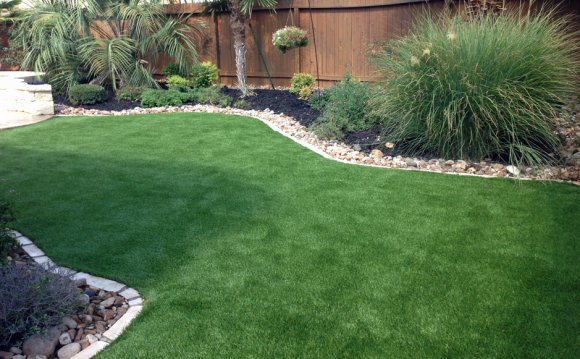
ED JOYCE (KPBS Reporter): San Diegans spend a lot of time and money maintaining lawns. They also use a lot of water keeping them green. But not Alpine homeowner Dianne Barnaba. Barnaba pulled out the natural grass in the front and backyard of her home. She replaced it with 750 square feet of synthetic grass. The artificial turf covers a small patch in the front yard and more in the back yard.
DIANNE BARNABA (Alpine Homeowner): There was lots of gopher holes, tons of dirt, big dirt mounds. And although the dirt was great for plants it wasn't good for the yard. And we had two dogs so we had to always try and figure out how to cover up the brown spots. And then the biggest thing probably besides the gophers, were the rabbits. We had tons of rabbits coming in in the morning and at night grazing eating all the grass down to the nub.
JOYCE: Four years ago, Barnaba re-landscaped the property, adding drought-tolerant plants and the synthetic turf. She says replacing the real grass cut her water bills in half.
BARNABA: And my husband's back was saved quite a bit because he didn't have to mow and weedwhack.
JOYCE: Barnaba bought her synthetic grass from Escondido-based Easy Turf. Easy Turf regional sales manager MarkRradeke says the company's field turf product is a good substitute for real grass.
MARK RADEKE (Easy Turf): You know, our turf is extremely environmentally-friendly. The infill for instance, is, it's crumb rubber, it's recycled tires. For instance, to do a football field it takes 100, 000 recycled tires. That's 100, 000 tires that aren't sitting in a landfill somewhere. Plus the whole product is 100 percent recyclable. Besides that you're not putting nitrates, fertilizers, things like that into the ground. So it really is the perfect green alternative.
JOCYE: The recycled tires are used for cushioning. Radeke says the synthetic green polyethlene blades are lead and toxic-free. Polyethylene is a type of plastic, the same material used in grocery store bags. He says the fake turf does get a bit warm on days when the temperature reaches 90 degrees or higher. But a spritz on the turf with a hose drops that heat, at least temporarily. Radeke also says the field turf is porous so it allows water to soak through to the ground. He says the average cost is roughly $8 to $14 per square foot depending on type of turf, ground preparation and access issues. Radeke says business for the company has picked up significantly in the past three years as the cost of water has climbed. He also says the turf is now considered a viable landscaping option. But does the synthetic turf really feel like natural grass? We put it to the barefoot test. - Feels like grass to me. - While the synthetic grass may feel good on my bare feet, some say it's bad for the environment.
NAN STERMAN (Garden Expert): To me, artificial grass is just artificial. It doesn't belong in a garden. It's outdoor carpeting.
JOYCE: Nan Sterman is a proponent of drought-tolerant landscapes. She's written two books on California gardening.
STERMAN: Grass has some advantages. Grass does take carbon out of the air, grass does cool the air, it does filter runoff and rainwater, etc. We just don't have enough natural rainfall to keep it going without a lot of artificial means. So, if you can't keep grass going without artificial means, why have artificial grass? It doesn't serve any purpose other than being a green carpet.
JOYCE: Sterman recommends using drought-tolerant plants and a combination of soil and other ground covering instead of synthetic or natural grass. Dylan Edwards manages the Ocean Friendly Gardens Program for the surfrider Foundation. Edwards says synthetic turf does help conserve water. But surfrider is concerned about runoff.
DYLAN EDWARDS (Surfrider Foundation): But underneath that synthetic turf you have this really unhealthy compacted soil, and so the rainwater comes down hits the synthetic turn, a chunk of it gets absorbed. But a vast majority of it runs off into the streets and into the gullies, the storm drains, and ultimately into the oceans.















